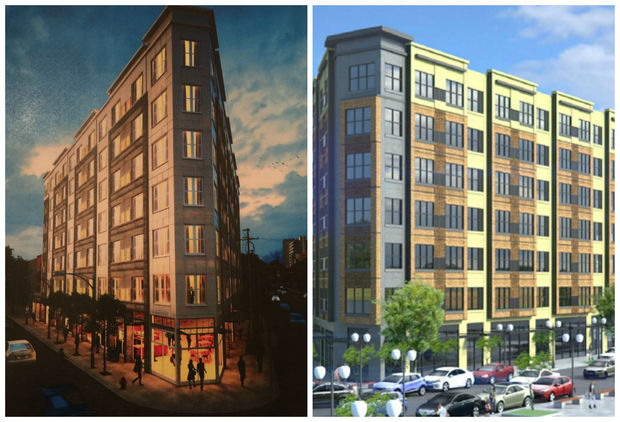The Greater Goethe Neighborhood Association in Logan Square is arguing that the neighborhood's "current infrastructure" can't handle approximately 120 more people moving into a planned LGTB-friendly and transit-friendly affordable housing development at 2013 N. Milwaukee Ave. A group of affordable housing developers has proposed an 88-unit building that would replace the current Congress Pizza and its parking lot.
However, Logan Square infrastructure is actually well-suited to accommodate those new residents. The neighborhood could potentially take in ten times that many people without a problem.
The building and its plaza will be named for John Pennycuff and Robert Castillo, two men who were partners in life and activism, advocating for LGBT rights as well as affordable housing in Logan Square. Pennycuff passed away in 2012.
The planned building is correctly called a transit-oriented development because it would be located just over one block away from the Blue Line's O'Hare branch and have a mere 18 off-street parking spaces. In the past, the city's zoning rules generally required residential buildings to include one car parking space per unit, with a lower minimum parking ratio for affordable housing buildings. However, the city's recently passed TOD ordinance waives the car parking requirement for developments near rapid transit.
If we assume that each of the 28 planned studio apartments will have a single person living in them, the 48 one-bedroom units will be a mix of single and double occupancy, and the 12 two-bedroom units will have a mix of double and triple occupancy, that means that about 120 people will live at the Pennycuff Apartments. But that proposal doesn't fly with the Greater Goethe Neighborhood Association's (boundary map), whose Zoning and Planning Committee recently submitted their opinion on the proposal to 1st Ward alder Joe Moreno.
They wrote, "Current infrastructure cannot sustain the increase in density and ZAPC would like to know how is this is being addressed by the City... The density is of major concern for the surrounding residents of the proposed project and is not received favorably." The letter doesn't explain why and how they feel that current infrastructure couldn't accommodate the new residents.
The neighborhood group is asking that the height of the building and the number of units be reduced. That's unfortunate, because the neighborhood desperately needs more affordable housing units, and the best way to provide them is by building near transit, which makes it easy for residents to get around without being dependent on driving.
Moreover, Logan Square's current population is much, much lower than the neighborhood's peak population during the 20th Century. The community area has lost 11 percent of its population from 2000 to 2010, and even more since 1950.
These 88 affordable units will help make up for the loss in units in the neighborhood that has been caused by multi-unit buildings being torn down in the past, which is still an issue as older rental buildings are replaced by upscale single-family homes.
Here's how I propose the neighborhood association's concerns should be addressed:
- Measure the impact of new housing on current infrastructure (housing availability and pricing, sewer, transportation, roads, and parks).
- Measure the impact of converted or demolished housing on current infrastructure.
- Measure the potential impacts of not building the proposed residences.
The city adopted a plan for the Milwaukee Avenue corridor in 2008. As far as neighborhood plans go, it's a pretty good one, so it would be nice to try and stick to the plan for once.
The Milwaukee Avenue Corridor Plan, which covers the street segment between Western and California Avenues, calls for building more housing:
Higher density housing is often attractive for young couples, as well as new families, singles, and empty-nesters looking to downsize their housing units and spend less time on home maintenance and repair. These residents are drawn to urban living because of the goods and services that are available in pedestrian-oriented environments.
Taller buildings would continue the streetwall found along other sections of the Corridor. This would accommodate higher density housing to maximize the number of residents in the area who could conveniently take advantage of the existing transportation and the existing stores, restaurants and services located along the Corridor.
These housing types will help build the immediate population density necessary to create a vibrant and growing Study Area.
DNAinfo reported that the Pennycuff project was well-received, and vocally supported, by those who attended a public hearing last week.
At the meeting Pennycuff's partner Castillo, for whom the building's public plaza will be named, brought up the need for more affordable housing in Logan Square, according to DNAinfo. "It is also needed because the reality of Logan Square is the rents have risen and a lot of longtime neighbors have left."
Moreno should take the letter from the GGNA's zoning and planning committee letter with a grain of salt. A mere seven people wrote it, and they should not be allowed to have undue influence on suppressing opportunities to build additional affordable housing units as the neighborhood's population grows again.
Did you appreciate this post? Support Streetsblog Chicago and donate.



